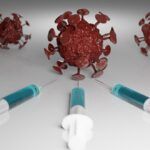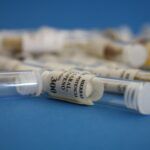Converging evidence shows that viruses such as SARS-CoV-2 and influenza are mainly transmitted through the air. Merging the two non-contact transmission modes, large-droplet and aerosol, into a unique non-contact airborne transmission mode, is essential to break the chain of infection, according to a new JRC study.
When you breathe, speak, laugh, cough, sneeze or sing you produce droplets, small and bigger ones. If these respiratory droplets are generated by an infectious individual, they may contain viruses.
Respiratory viruses, such as SARS-CoV-2 or influenza, have traditionally been associated with three modes of transmission:
- Contact: the transmission happens through direct contact with infected people (e.g. hand shaking) or surfaces;
- Droplet: infection occurs via direct ballistic deposition of virus-containing large respiratory droplets (bigger than 5 μm) onto the mouth, nose, or eyes of an individual;
- Airborne (or aerosol): a person gets infected by inhaling small droplets (smaller than 5 μm). These remain suspended in the air longer than large droplets and thus they can spread over longer distances.
JRC scientists call into question the demarcation between droplet and airborne transmission. In previous work dated back as early as 2008 and more recently in April 2020 and May 2021, they have been calling for a revision of the guidelines on the modes of transmission of respiratory viruses.
In a new study published in May, they propose to merge the two non-contact transmission modes, large-droplet and aerosol, into a unique non-contact airborne transmission mode.
The importance of aerosol transmission
The airborne route is a potentially important transmission pathway for SARS-CoV-2 or influenza in indoor environments.
However, scientists in the medical community have been emphasising that large droplets are mainly responsible for respiratory virus transmission, indicating that aerosol transmission is much less important. This position seems to have finally changed a couple weeks ago with the updates related to SARS-CoV-2 in the USA, Centers for Disease Control and Prevention (May 7, 2021), and the WHO (April 30, 2021).
The main argument for the reluctance to accept airborne transmission as a major pathogen transmission mode is that when one takes an air sample to isolate the virus to cultivate it experimentally, they fail to cultivate it. To them, this means that the virus is inactivated.
But, according to JRC scientist Nikolaos Stilianakis, “there are many reasons to justify this inactivation of the virus, but this does not mean that viable virus is not present in the airborne droplets.”
He says: “The until recently prevailing view that large droplets are mainly responsible for virus transmission rather than fine airborne droplets is based on knowledge of the early 1900s and misconceptions. It is encouraging to see the very recent update of the USA CDC and WHO recommendations finally pointing in the right direction”.
Updating public health interventions
This new definition of a unique non-contact airborne transmission mode has significant repercussions on public health interventions to break the chain of infection, specifically regarding
- the type of masks that we should wear indoors. The proposed unified mode of aerosol transmission implies that the traditional distinction of face coverings into those that provide source control (e.g., surgical masks that protect others from droplets emitted by the wearer, outward protection) and susceptible control (e.g., N95 respirators that protect the wearer, inward protection) should be reconsidered. Both types of face coverings provide inward and outward protection of varying degree depending on numerous factors including the size of the emitted respiratory droplet, the material they are made of, and how well they fit a person’s face.
- the spatial separation between two persons indoors. The current measure of standing one or two meters away from other people would not be enough in case of airborne transmission;
- the ventilation: if people are in an indoor environment that is not well ventilated, even a distance of 2 meters between people may not be enough. The efficiency of ventilation as a control measure depends on the ambient air velocity. In indoor ventilated environments, for higher ambient-air velocities, the infection probability decreases since droplets are rapidly removed (expose to the virus is minimized).







Leave a Reply